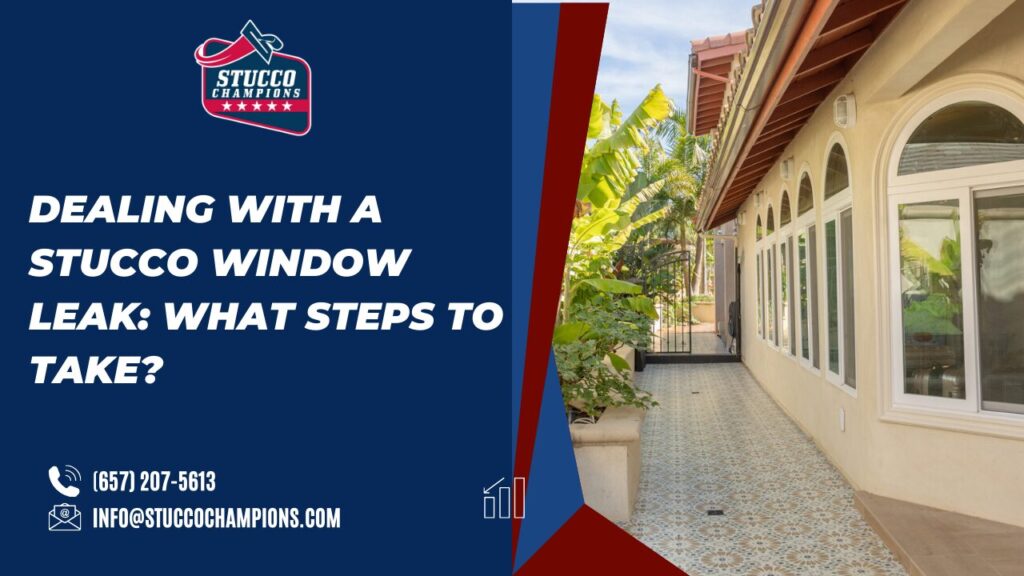Experiencing leaks around stucco windows can be concerning for homeowners. As a certified professional in stucco repair and window installation, I aim to guide you through identifying and fixing such leaks, drawing from extensive field experience.
Determining the Source of the Leak: Firstly, ascertain whether the leak originates from the window itself or from the stucco. This distinction is crucial for choosing the correct repair approach.
Testing for Leaks:
- Interior Inspection: Remove the interior drywall around the window to inspect the condition of the plywood/OSB (Oriented Strand Board) and framing. This step provides a clear view of any water intrusion.
- Window Test: Seal the window’s face with waterproof tape (such as vinyl or duct tape) and cover it with thick plastic. After spraying water on this setup, look for leaks. This process helps isolate the window from external factors.
Common Causes of Leaks:
- Flashing Issues: In my experience, improper or deteriorated window flashing often causes leaks. Correct installation is critical to prevent water penetration.
- Stucco Paper Deterioration: Damaged or deteriorated stucco paper, which serves as a moisture barrier, can also lead to leaks.
Caulking as a Temporary Solution: While caulking around windows can temporarily seal minor cracks, it’s not a long-term solution for underlying problems. Over time, continued water intrusion can cause significant damage to structural elements.
Comprehensive Leak Repair: If the leak is attributed to the window flashing or stucco, a thorough inspection and repair are necessary. This involves:
- Removing stucco around the window (typically 6-9 inches).
- Inspecting and repairing or replacing window flashing and stucco paper.
Professional Assistance: For significant leaks or complex situations, seeking professional help is advised. Experts can efficiently diagnose and fix the issue, ensuring long-term effectiveness.
Cost Estimation: Repair costs can vary widely based on several factors, including:
- Window location and accessibility.
- Presence and complexity of window trim.
Type of stucco system (three-coat, one-coat, EIFS).
- Stucco finish and the need for custom color matching.
- Window size and condition.
- Specifics of flashing and caulking needs.
Generally, repair costs range from $400 to $1800+, with variations depending on these factors.
Preventing Future Leaks:
- Regular Maintenance: Regularly inspect windows and stucco for any signs of wear, cracks, or deterioration. Early detection can prevent more significant issues.
- Professional Inspections: Periodic checks by a stucco or window expert can help identify potential problems before they result in leaks.
Alternative Testing Methods: If removing drywall is impractical, consider alternative testing methods such as:
- Infrared thermography to detect moisture.
- Water spray tests conducted by professionals.
- Careful exterior inspection around the window for visible signs of damage or wear.
Transparency and Product Recommendations: All product recommendations are based on my professional experience and effectiveness. I have no affiliations with specific brands, and any affiliate links are clearly indicated for full transparency.
Conclusion: Identifying and repairing stucco window leaks require a methodical approach to diagnose the exact cause. Whether it’s a DIY task or necessitates professional assistance, understanding the underlying problem is key to effective repair. Regular maintenance and early detection play crucial roles in preventing future leaks, ensuring the longevity and integrity of your stucco and windows.
Last week, we shared Understanding the Thickness of Various Stucco Walls: A Detailed Analysis, exploring how different wall thicknesses impact durability, insulation, and aesthetic appeal. If you’re planning a stucco project, be sure to check out this detailed guide for expert insights!
—

